Chapter 10. Linguistic models
Abstract
The OMG Software Assurance Ecosystem uses the OMG standard Semantics of Business Vocabularies and Rules (SBVR) to analyze and represent cybersecurity knowledge as formal machine-readable content that can be directly used by assurance tools, but at the same time allow human readable statements in Structured English as well as other controlled natural languages. SBVR defines linguistic models of systems. A common vocabulary is a subset of a linguistic model, focusing on the efficient information exchanges based on a predefined format. Linguistic models can represent new meanings, including new patterns and statements beyond the predefined set. Within the OMG Assurance Ecosystem, SBVR is used to formalize security policy, define patterns and exchange vocabularies, and define rules and patterns using a standard protocol. SBVR content involves cybersecurity and system vocabularies (introduced in 4, 5, 6 and 7) as well as the standard vocabulary for system facts (described in the next chapter).
Keywords
linguistic model, software assurance ecosystem, semantics of business vocabularies and rules, sbvr, information exchange, vocabulary, formalization, pattern
-The name of the song is called ‘Haddock’ Eyes'.
-Oh, that's the name of the song, is it?
-No, you don't understand. That's what the name is called. The name really is ‘The Aged Aged Man’.
- Then I ought to have said ‘That's what the song is called’?
- No, you oughtn't; that's quite another thing! The song is called “Ways and Means’: but that's only when it's called, you know!
- Well, what is the song, then? said Alice, who was by this time completely bewildered.
-I was coming to that, the Knight said. The song really is ‘A-sitting On A ‘Gate’: and the tune's my own invention.
—Lewis Carroll, Through the Looking-Glass
10.1. Fact models and linguistic models
Linguistic models deal with statements as they are used to express meanings. While fact models focus on simple operational meanings within a given conceptual commitment (existence of objects, discernability of objects as representatives of certain concepts, characteristics of individual objects and relationships between objects), linguistic models focus on meanings corresponding to the conceptual commitment itself, regardless of the actual objects, such as what are the characteristics of concepts, how concepts are defined in terms of other concepts, and what relationships between concepts are necessary, permissible or obligatory. Thus statements in fact models describe individual views while statements in linguistic models describe viewpoints. Linguistic models focus at the definitions of new meanings, therefore they facilitate unconstrained communications where new meanings are defined on-the-fly. The flexibility of unrestricted linguistic communication comes with a price: the intended meaning needs to be unraveled from the expression, and the more complex the meaning, the more complex is the unraveling process. The key challenge of unrestricted linguistic communication is not so much in parsing a natural language sentence (which can be quite complex) but rather in dealing with complex meanings that are defined on-the-fly by some sentences and are used in the follow-up sentences. For example, we can say: “Remember the nuts-and-bolts illustrations from the previous chapter? Did you notice that there are a total of 35 nuts visible in these figures?” While humans routinely deal with the dynamic updates to the conceptual commitment, it is a barrier for machine-to-machine information exchanges.
Fact models, on the other hand, facilitate constrained communications in which the vocabulary is preselected; the forms of expressing this meaning are preselected, and consequently the range of meanings is bounded. Fact models do not define new meanings on-the-fly. Instead, they simply express meanings from the preselected set defined by the vocabulary. These boundaries (the vocabulary, the form of expressing meanings, and the intended range of meanings) become the contract between the participants of the information exchange. This contract is essential for repeatable information exchanges, which is a two-phase process: First, the scope of communications is bounded and the contract is established, and then the actual exchanges start flowing. Linguistic models are efficient in the first phase, but fact models are used for the second phase. Each fact model is tailored to a specific contract. Although it is tempting to say that a fact model is the contract itself, there are several more aspects of interoperability in addition to the exchanged meanings and the agreed upon form of expression of meaning. These additional aspects include locations, responsible contact points, trust, monetization, quality, and so on. It is not surprising that the fact models are also used for conceptual definition of the information systems.
Figure 1 compares linguistic models to fact models and ontologies. Ontology is a branch of philosophy that deals with questions concerning what entities exist or can be said to exist, and how such entities can be grouped, related within a hierarchy, and subdivided according to similarities and differences. However, recently this word has been commonly used in a more applied sense as a formal representation of the knowledge of a particular domain by a set of concepts and the relationships between those concepts. Linguistic models as well as fact models describe entities and their relationships in the real world, or in any possible world, regardless of whether these entities and relationships exist or could potentially exist. Fact models separate concrete (operational) knowledge of the actual things and relationships between them (known as facts), and the general knowledge of what kinds of things and kinds of relationships can be described (known as the conceptual schema). Linguistic models do not make this distinction, instead they focus on concepts and those relationships that are necessary, permissible or obligatory between concepts regardless the instances of these concepts or the instances of the relationships. This is the reason why linguistic models provide the foundation for describing business rules, i.e. the statements of behavior guidance.
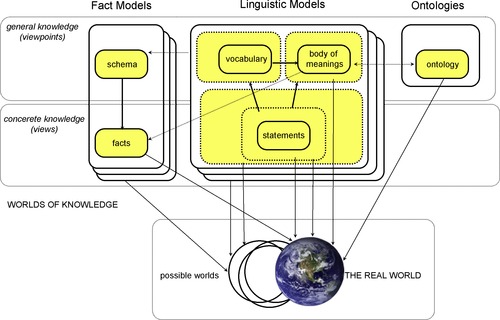 |
| Figure 1 Linguistic models and fact models |
Linguistic models involve a body of meanings and a vocabulary to express meanings, as well as a mechanism to construct statements that can define new meanings based on the initial ones. This mechanism makes linguistic models unbounded compared to fact models.
10.2. Background
The Semantics of Business Vocabularies and Business Rules (SBVR) is a publicly available specification from the Object Management Group (OMG) [SBVR]. It was developed by 17 organizations in 7 countries and adopted by OMG in September 2005. It was published as a formal OMG specification in January 2008. The word “business” emphasizes the fact that SBVR focuses on conceptual models that directly represent the operational vocabulary of systems, related to the business mission of the system, as opposed to any implementation views used by the downstream stages of the system life cycle. The terms business model and conceptual model are often used as synonyms [Bridgeland 2009][Halpin 2008][Olive 2007][Ross 2009] and [Ross 2003].
SBVR provides the provides the following means for building linguistic models:
• Defining vocabularies as a cohesive set of interconnected concepts, not just a list of terms and definitions;
• Defining behavioral guidance (policy, rules, etc.) that govern the actions of subject of the conceptualization that is defined by means of a vocabulary;
• Exchanging vocabulary definitions, rules, and patterns.
The OMG Assurance Ecosystem uses SBVR to analyze and represent cybersecurity knowledge as formal machine-readable content that can be directly used by assurance tools but at the same time allow human readable statements in structured English as well as other controlled natural languages. Another use of SBVR within the Assurance Ecosystem is to define patterns as fragments of interconnected concepts that can be used as queries and matched against fact models.
10.3. Overview of SBVR
The SBVR provides the means to build linguistic models, including propositions, questions, rules, and corresponding conceptual schemes and vocabularies. The SBVR specification consists of six major parts (illustrated at Figure 2):
• Elementary meanings (vocabulary for describing elementary meanings, including the conceptual schema)
• Composite meanings (vocabulary for defining new meanings including propositions, questions and rules, based on elementary meanings)
• Expressions (very small vocabulary dedicated to the building blocks of written communications that are commonly used to express meanings)
• Representations (the building blocks of vocabularies that bring together expressions and their meanings)
• Vocabularies (a very small vocabulary for defining vocabularies as collections of representations)
• Extensions, or the “things that are meant by meanings” (a very small vocabulary to describe the referents of concepts, the “objects” and the “facts”)
 |
| Figure 2 Overview of SBVR |
SBVR captures business concepts and business rules that may be expressed either informally or formally. Business rule expressions are formal only if they are expressed purely in terms of the preselected conceptual schema for the business domain and semantic formulations, including certain logical and mathematical operators, logical quantifiers, and so on. Formal rules can be exchanged as content with other rules-based software tools [Leuf 2006]. Informal rules may be exchanged as uninterpreted comments.
The SBVR specification defines a standard protocol for exchanging vocabularies, rules, and patterns, including an XML Schema [XML].
10.4. How to use SBVR
Let's look at some practical uses of SBVR. First, we will see how SBVR is used to define a simple conceptual scheme based on well-known, informally defined terms. Then we will look at how to formalize propositions using the SBVR vocabulary. Finally, we will show how propositions are used to define new elements of the vocabulary.
10.4.1. Simple vocabulary
Before we can make any meaningful statements, we need to agree on a conceptual schema that includes some noun and verb concepts as well as some individual concepts. Concepts are defined and expressed as terms and other symbols, and they are represented as vocabulary entries in SBVR Structured English. Below is an example of the nuts-and-bolts vocabulary from Chapter 9 in SBVR.
Nut
Definition:a hardware fastener item that has threaded hole into which an appropriate bolt can be screwed to fasten things together.
Source:based on wikidedia (english)
Concept type:noun concept
Note:this is an informal definition of a noun concept
Reference scheme:id of nut
Bolt
Definition:threaded pin that screws into a nut and is used to fasten things together
Source:New Oxford American Dictionary 2nd edition, 2005
Reference scheme:id of bolt
Washer
Definition:a small ring made of metal, rubber or plastic fixed under a nut or the head of the bolt to spread the pressure when tightened or between two joining surfaces as a spacer or seal
Source:New Oxford American Dictionary 2nd edition, 2005
Reference scheme:id of washer
Nutis screwed ontobolt
Definition:the actuality that nut is fastened onto bolt
Concept type:verb concept
Note:this is an informal definition of a verb concept
Washeris fastened onbolt
Definition:the actuality that washer is fixed onto bolt
Washer1is abovewasher2
Definition:the actuality that washer1 and washer2 are fastened on the same bolt in such order that washer1 is closer to the head of the bolt than washer2
Synonymous form:washer2is belowwasher1
Nuthasid
Concept type:characteristic
Bolthasid
Concept type:characteristic
Bolthashead
Concept type:characteristic
Washerhasid
Concept type:characteristic
Nut n-2
Definition:the nutthathasid “n-2”
Note:this is a definition of an individual concept
Bolt b-25
Definition:the boltthathasid “b-25”
10.4.2. Vocabulary entries
A vocabulary is described in a document (or document section) that features glossary-like entries for concepts that have representations in the vocabulary. Each entry starts with a primary representation, which is either a designation or a template of expression for the concept and is followed by several captioned details for the concept. Neither the order of vocabulary entries nor the order of caption details inside the entry is significant. Here is a skeleton of a vocabulary entry with captions.
Primary representation
General concept: designation of the general concept
Definition: statement or text
Description: text
Dictionary basis: text of the citation for externally defined terms
Source: vocabulary reference for externally defined terms
Example: text
Note: text
See: reference to the preferred representation
Synonym: alternative designation
Synonymous form: alternative designation
A typical primary representation of a noun concept is its designation. The primary representation for a verb concept (fact type) is a template of expression with a placeholder for the roles. A subscript on each placeholder can be given in cases where the same designation is used for more than one placeholder, so that references to the roles within the entry are unambiguous (see verb concept “washer-1 is above washer-2” in the nuts-and-bolts vocabulary). Designations usually do not include quantifiers (including articles) and logical operators.
The following list describes some simple captions. More advanced captions are introduced later in this chapter.
• Source caption cites an external source that relates to a concept's meaning. The source's designation for the concept (which might not match the entry's primary representation) is given in square brackets and is quoted after the name of the source. The keywords “based on” indicate that the definition of the concept is largely derived from the given source but had some modification.
• Example caption provides examples involving the entry concept.
• Note caption is used to label explanatory notes that do not fit within the other captions.
• Synonym describes another designation that can be substituted for the primary representation of a noun concept. It is a designation for the same concept.
• See provides a caption that introduces the preferred representation where the primary representation is not a preferred representation for the entry concept. No definition is given in this case.
• Synonymous Form is an alternative template of expression for the same verb concept; for example, the synonymous form can be a passive form of the primary representation or one that reverses the order of roles. The meaning of two templates of expression being synonymous is that the two represent the same verb concept.
10.4.3. Statements
Statements are expressions of propositions, questions, and rules. SBVR defines the so-called SBVR Structured English notation that uses English vocabulary to state propositions, questions, and rules (and not graphical diagrams, not a formal logical language, like Prolog, and not XML).
Here are some examples of statements using the above nuts-and-bolts vocabulary:
Nut n-2is screwed ontoBolt b-25
Nut n-2 is not a bolt
Nut n-2 has id “n-2”
Somenutis screwed ontoBolt b-25
Eachnutis screwed ontosomebolt
Exactly onenutis screwed ontoBolt b-25
It is not the case that2nutsare screwed ontoBolt b-25
It is prohibited that2nutsare screwed ontoabolt
It is possible that more than onewashersare fastened onabolt
10.4.4. Statements as formal definitions of new concepts
Each SBVR vocabulary is created for a particular speech community. Since this book is written in English, all our examples assume an English language speech community. SBVR separates the meaning from its expression, so that when the SBVR vocabulary is exchanged, new expressions can be associated with the given meanings, for example in German, creating a vocabulary for the different speech community. Two vocabularies can share the same structure of meanings. Thus a particular meaning is defined not by a particular word, but rather by the structure of the meaning, including the verb concepts and the unique characteristics of the concept, regardless of the language in which they are expressed. SBVR defines a large set of these structures of meaning, called semantic formulations, illustrated at the end of this chapter.
10.4.4.1. Definition of a noun concept
A common pattern of definition begins with a designation for a more general concept followed by the keyword “that” and then an expression of necessary and sufficient characteristics that distinguish a thing of the defined concept from other things of the more general concept. Another, less used pattern also leads with a designation for a more general concept but then uses the word “of” with another expression.
Two kinds of information are formally expressed by a fully formal definition.
1. A fact that the concept being defined is a category of a particular more general concept.
2. A closed projection that defines the concept.
Only the first kind of information is formally expressed by a partially formal definition. A partially formal definition leads with a styled designation that is for a more general concept. That designation is generally followed by the keyword that and then an informal expression of necessary and sufficient characteristics.
Definitions of the individual concepts nut n-2 and bolt b-25 above are fully formal. Other definitions are partially formal or informal.
Another style of formal definition is extensional. Usually the extensional style uses disjunction to combine a number of concepts.
10.4.4.2. Definition of a verb concept
A definition given for a verb concept (fact type) is an expression that can be substituted for a simple statement expressed using a template of expression of the fact type. The definition must refer to the placeholders in the template of expression. This is done in order to relate the definition to the things that play a role in instances of the fact type. Whether or not the definition is formal, each reference to a placeholder appears in the “noun concept” font and is preceded by the definite article, “the”.
10.4.4.3. The general concept caption
The General Concept caption can be used to indicate a concept that generalizes the entry concept. This is not needed if there is a definition that starts with the general concept, but it is helpful in cases where a definition is not provided, such as is often the case for individual concepts (named things) or concepts taken from a source.
10.5. SBVR vocabulary for describing elementary meanings
SBVR itself is defined as several vocabularies. The noun concepts of the SBVR vocabulary for defining elementary meanings are illustrated in Figure 3.
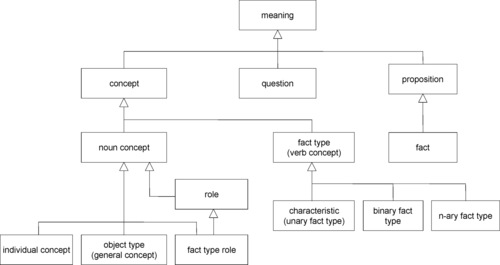 |
| Figure 3 The elements of meaning in SBVR: noun concepts |
The following fragment illustrates the original definition of SBVR in SBVR:
Meaning
Definition:what is meant by a word, sign, statement, or description; what someone intends to express or what someone understands
Concept
Source:ISO 1087-1 (English) (3.2.1) [‘concept’]
Definition:unit of knowledge created by a unique combination of characteristics
General Concept:meaning
Reference Scheme:a designation of the concept
Noun concept
Definition:concept that is the meaning of a noun or noun phrase
Reference scheme:a closed projection that defines the noun concept
Object type
Definition:noun concept that classifies things on the basis of their common characteristics
Source:based on ISO 1087-1 (English) (3.2.3) [‘general concept’]
Synonym:general concept
Necessity:the set of characteristics that are incorporated by an object type is not the set of characteristics that are incorporated by another object type
Note:an object type incorporates a set of characteristics which are a unique combination that distinguishes this object type from all other object types. (See ‘concept incorporates characteristic’). If an object type A and an object type B have the very same incorporated characteristics, they are the same concept. If they have the very same necessary characteristics, they are logically equivalent and they denote the same things in all possible worlds.
Example:the concept ‘nut’ corresponding to the hardware fastener
Example:the concept ‘number’, the concept ‘person’
Individual concept
Source:ISO 1087-1 (English) (3.2.2) [‘individual concept’]
Definition:concept that corresponds to only one object [thing]
General concept:noun concept
Necessity:No individual concept is an object type
Necessity:No individual concept is a fact type role
Characteristic
Definition:fact type that has exactly one role
Source:ISO 1087-1 (English) (3.2.4) [‘characteristic’]
Definition:Abstraction of a property of an object [thing] or a set of objects.
Synonym:unary fact type
Note:A characteristic always has exactly one role, but it can be defined using fact types having multiple roles
(in SBVR formatting):
Fact type Definition:concept that is the meaning of a verb phrase that involves one or more noun concepts and whose instances are states of affairs
Synonym:verb concept
Note:For each instance of a fact type, each role of the fact type is one point of involvement of some object in that instance
Necessity:Each fact type has at least one role
The concept “characteristic” is an abstraction of some property intrinsic to each instance of the concept; the collection of essential characteristics makes up the concept. Two definitions can describe the same object by producing the same set of incorporated characteristics. Noun concepts were informally introduced in Chapter 9. Unique characteristics of the concept allow discerning the objects of this concept.
Some relationships between the SBVR concepts are illustrated at Figure 4.
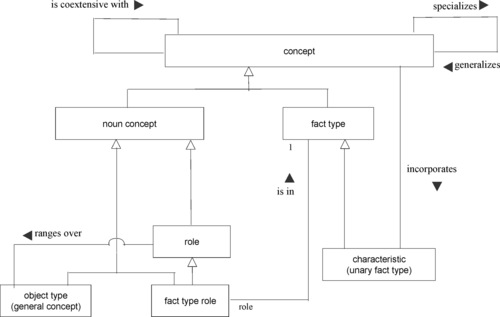 |
| Figure 4 The elements of meaning in SBVR: verb concepts |
The role is an abstraction of a thing involved in an instance of the verb concept. The verb concept with the designation ‘verb concepthasrole’ identifies the set of roles for another verb concept (a fact type is a synonym for a verb concept) the inverse relation is described by the verb concept ‘fact type roleis infact type’.
Roles are related to the characteristics of the concept (an object type, to be precise). The verb concept ‘Roleranges overobject type’ identifies the corresponding characteristic. For example, the role ‘company’ of the verb concept ‘company employs person’ ranges over the object type ‘company’.
The verb concept ‘Concept1specializesconcept2’ is the key to developing intentional definitions. This verb concept is defined by the following statement: ‘Concept1 incorporates each characteristic that is incorporated by the concept2 plus at least one differentiator.’ A synonymous form for this verb concept has the designator ‘Concept2generalizesconcept1.’
For example, the noun concept ‘whole number’ specializes the noun concept ‘integer,’ the differentiator being that whole numbers are nonnegative. As another example, the individual concept ‘Cyber Bricks’ specializes the concept ‘company,’ the differentiator being that Cyber Bricks is one particular fictitious company used in the case study for this book.
Semantic integrations often involve recognizing where different concepts (having different intentional definitions) have the same extensions in all possible worlds. Also, it is possible that concepts employing different methods of conceptualization have the same extension in all cases. For example, the individual concept defined as ‘the owner of the Clicks2Bricks system’ is coextensive with an object type defined as ‘the companies featured in the case study of this book.’ The two companies have the same extension (which includes only ‘Cyber Bricks’), but they are different concepts. The corresponding relation between concepts is represented using the designator ‘Concept1 is coextensive withconcept2.’
Propositions and Questions are also meanings. Proposition is defined as meaning that is true or false. A proposition corresponds to a state of affairs in a possible world defined by a collection of things of interest and possibly a time frame. The same proposition can be true in one possible world and false in another. Note that the word “proposition” has two common meanings: first, a statement that affirms or denies something, and second, the meaning of such a statement. The SBVR concept ‘proposition’ is defined in the second sense and should not be confused with the statement of a proposition.
A Fact in SBVR is defined as a proposition that is taken as true. How one ascertains what is true, whether by assertion, observation, or other means, is outside of the scope of SBVR. However, ascertaining the validity of certain propositions (the assurance claims) is the central concern of system assurance. Note that SBVR is a linguistic model, so the definition of a ‘fact’ is slightly different from the one we introduced in Chapter 9. However, the two definitions are in alignment.
The following characteristics of propositions defined in SBVR are important for assurance:
Propositionis necessarily true—The proposition always corresponds to an actuality; a proposition is considered to be necessarily true if it is true by definition—the definitions of relevant concepts make it logically impossible for the proposition to be false.
Propositionis possibly true— It is possible that the proposition corresponds to an actuality.
Propositionis obligated to be true—The proposition corresponds to an actuality in all acceptable worlds.
Propositionis permitted to be true—The proposition corresponds to an actuality in at least one acceptable world.
Question is defined as the meaning of an interrogatory. Note that the word “question” has two common meanings: first, a written or spoken expression of inquiry, and second, the meaning of such an inquiry. By the second definition, a single question can be asked in two languages. But by the first definition, using two languages results in two expressions, and therefore, two questions. The SBVR concept “question” is defined in the second sense (meaning) and should not be confused with the expression or representation of a question.
10.6. SBVR vocabulary for describing representations
The following definitions tie together the three major areas of SBVR:
Expressionrepresentsmeaning
Definition:the expression portrays or signifies the meaning
Representation
Definition:the actuality that a given expression represents a given meaning
Necessity:each expression has exactly one meaning
Necessity:each representation represents exactly one meaning
Representationhasexpression
Representationrepresentsmeaning
Synonymous form:meaning has representation
Synonymous form:representation has meaning
The noun concepts of the SBVR vocabulary for defining representations are illustrated in Figure 5.
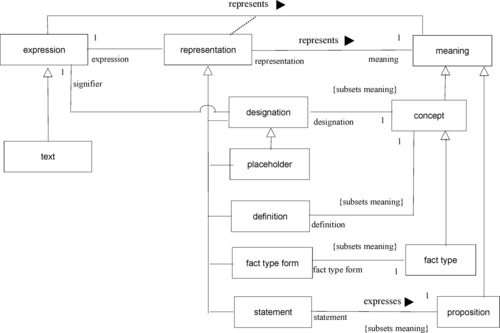 |
| Figure 5 The elements of representation in SBVR |
A Designation in SBVR is a representation of a concept by a sign that denotes it. (This may include a specific namespace that includes the designation to allow disambiguation of terminology when integrating statements from different communities.) Designation involves a signifier, which is the expression of the designation. For example, the concept ‘nut’ has a signifier, which is a string produced by concatenating the characters “n,” “u,” and “t.” The signifier exists only in the context of a designation, so the string “nut” on its own may be interpreted in many diverse ways.
A Definition in SBVR is a representation of a concept by a descriptive statement (expression), which serves to differentiate it from related concepts. A fully formal definition uses one of the semantic formulations, and its meaning is interpreted unambiguously.
Figure 6 illustrates the organization of the designators for verb concepts.
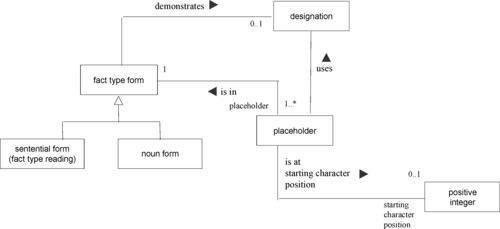 |
| Figure 6 The Fact Type Form |
A Fact type form in SBVR is a representation of some verb concept by a template of expression. For example, the fact type form ‘product of company’ demonstrates a designation ‘of’ and has two placeholders—one using the designation ‘product’ at the starting position 1 and the other using the designation ‘company’ at the starting position 12.
Sentential form (also known as a fact type reading) is a fact type form that is a template that can be used for starting a proposition based on a fact type.
Noun form is a fact type form that acts as a noun rather than forming a proposition. A noun form can have a placeholder for each role of a fact type, in which case the noun form result comes from the role the first placeholder serves. A noun form can have one less placeholder than there are roles, in which case the noun form result comes from the role that no placeholder is for. An example is ‘bolt of the nut-and-bolt assembly’ for the fact type ‘nut-and-bolt assembly has bolt.’ This noun form refers to the bolt. Another example of a noun form is ‘screwing nut’ for the fact type ‘nut is screwed onto bolt.’ This noun form yields the screwing act, which is an action. Gerunds are used in noun forms like this for actions, events, and states. They are used in sentences like this: ‘A nut must be screwed onto bolt after fastening the washer.”
SBVR distinguishes between the following three kinds of designation:
• Term—verbal designation of a general concept in a specific subject field (typically a common noun or noun phrase)
• Name—verbal designation of an individual concept (typically a proper noun)
• Icon—nonverbal designation whose signifier is a picture
Expression is defined as something that expresses or communicates, but is independent of its meaning (such as a sequence of characters, a sequence of sounds, a diagram, or an XML file). A Signifier is an expression that is a linguistic unit or pattern, such as a succession of speech sounds, written symbols, or gestures, used in a designation of a concept. Two particularly important kinds of expression are Text and Uniform Resource Identifiers (URI).
10.7. SBVR vocabulary for describing extensions
Earlier in this chapter we discussed the differences between linguistic models and fact models. SBVR provides the means for building linguistic models (including the definition of a conceptual schema for the fact model and stating what is necessary, permissible or obligatory in the world described by the conceptual schema). SBVR does not focus on statements of existence of the objects and relationships between the objects. The concept ‘individual concept’ is a point of alignment between fact models and linguistic models. However, the SBVR vocabulary includes terminology for describing the referents of concepts because this terminology is required to build statements and rules that define the semantics of other SBVR concepts. The linguistic perspective on the fact models defined in Chapter 9 is illustrated in Figure 7.
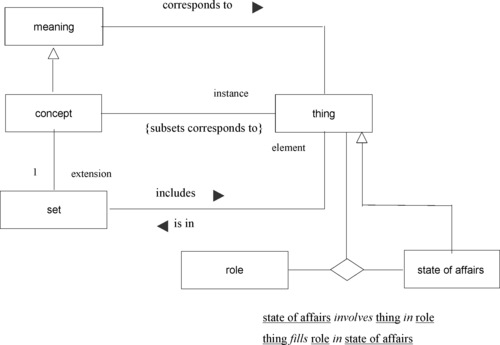 |
| Figure 7 The elements of extension in SBVR |
Extension is the totality of objects to which a concept corresponds. SBVR defines a concept ‘Thing’ (based on the ISO 1087-1 term ‘object’), as anything perceivable or conceivable. Every other concept in SBVR implicitly specializes the concept thing.
The concept ‘State of affairs’ is key to understanding verb concepts and their meaning. A state of affairs is any event, activity, situation, or circumstance. A state of affairs can be possible or impossible. Some of the possible ones are actualities (they occur in the actual world). A state of affairs is what is denoted by a proposition. A state of affairs either occurs or does not occur, whereas the proposition is either true or false. A state of affairs is not a meaning. It is a thing that exists and can be an instance of a concept, even if it does not happen. Conceptual commitment in the form of a vocabulary determines our viewpoint on what state of affairs we can consider.
10.8. Reference schemes
A reference scheme defines the chosen way of identifying instances of a given concept. Understanding reference schemes is critical for integrating facts from multiple sources during information exchanges. A reference scheme is a way of referring to instances of a concept through related things that are either lexical or are otherwise identifiable. A reference scheme usually uses one or more fact type roles of binary types in order to identify an instance of a concept from facts about the instance. A reference scheme can also use one or more characteristics. A reference scheme can be partial or complete. It is complete if it can always be used to refer to every instance of a concept. An overall complete reference scheme for a concept can result from there being multiple partial reference schemes for that concept, its more general concepts, and its categories. For example, the concept nut involves a characteristic id that is used to identify instances of this concept, for example ‘nut n-2’. Alternatively, a particular nut instance can be identified using its relationship to some other concept—for example, ‘the nut of the nut-and-bolt assembly that involvesboltb-52.’
The semantics of the reference scheme is illustrated in Figure 8.
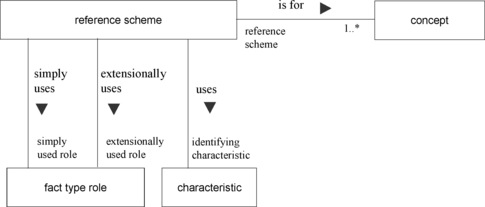 |
| Figure 8 Reference schemes in SBVR |
10.9. SBVR semantic formulations
Communications between humans generally use natural language to express propositions, although some technical propositions are at times expressed in a formal language, such as XML, C, or Prolog, or even graphically, such as a UML model. SBVR provides a means for describing the structure of the meaning of the proposition expressed in the natural language that business people use. SBVR calls this “semantic formulation.” Semantic formulations are not expressions or statements. They are structures that make up meaning. SBVR provides a vocabulary for describing them. By using SBVR, the meaning of a definition or statement is communicated as facts about the semantic formulation of the meaning, not as a restatement of the meaning in a formal language.
Semantic formulations contribute to SBVR Structured English through defining all keywords, as follows:
• Quantification keywords (each, some, at least one, at least n, at most one, exactly one, exactly n, at least n and at most m, more than one)
• Logical operations keywords (it is not the case that, and, or, or but not both, if then, if, if and only if, not both, neither nor, whether or not).
• Modal operations keywords (it is obligatory that, it is prohibited that, it is necessary that, it is impossible that, it is possible that, it is permitted that)
• Other keywords (the, a, an, another, a given, that, who, is of, what)
Semantic formulations make distinctions between expression, representation, meaning, and extension. Note how phrase ‘session hijacking is a threat to a web applications’ is interpreted differently in each of the following examples.
1. Expression (literal text): John did a Google search for ‘session hijacking is a threat to a web application.’
2. Representation (quoting a statement): Ron said, ‘session hijacking is a threat to a web application.’
3. Meaning (nominalization of a proposition): Ron said that session hijacking is a threat to a web application.
4. Extension (objectification of a proposition): Assessment disregarded that session hijacking is a threat to a web application.
SBVR provides a kind of formulation for nominalization of propositions, which makes a proposition to be an object of discourse as in (3). SBVR also supports nominalization of questions and interrogatives (“what,” “whether,” etc.). A separate kind of formulation accomplishes objectification, which makes the actuality or state of affairs that corresponds with a proposition to be an object of discourse as in (4) above. Number (2) involves a quoted statement, so its formulation identifies the statement as a combination of its text and its meaning (using nominalization).
10.9.1. Defining new terms and fact types using SBVR
SBVR provides the capability to define new terms and facts using semantic formulations. The OMG Assurance Ecosystem uses SBVR in combination with the standard protocol for exchanging system facts (the OMG Knowledge Discovery Metamodel, or KDM), [KDM] which describes a common vocabulary for system facts to define vendor-neutral assurance patterns. KDM is presented in Chapter 11 in more detail.
The following example uses SBVR to provide a formal definition of a new pattern—a statement that passes a format string to a format output function, which corresponds to the family of formatted output statements, like printf(). This definition was used in Chapter 7 in the example of the vulnerability pattern.
SBVR Structured English:
Action Elementpassesformat string to format output functionif
anAction ElementcallsaControl ElementwithNameand theAction Elementreadstheformat stringatpositionand theNameis a format string function atthatposition.
Supporting KDM noun concepts:
ActionElement
Control Element
Name
Position
Supporting platform-specific concepts:
Format String Function
Nameis a format string function forPosition
Supporting KDM verb concepts:
Action ElementcallsControl Element
Action ElementreadsData Elementatposition
Control ElementhasName
SBVR semantic formulation outline:
The verb concept “Action ElementpassesFormat Stringto format string function” is defined by an sbvr:setprojection (1)
The projection 1 is on the variable “Stmt”
The variable “Stmt” ranges over the noun concept “Action Element”
The projection 1 is on the variable “Fmt”
The variable “Fmt” ranges over the noun concept “Format String”
The projection is constrained by an sbvr:existentialquantification (1)
The existential quantification 1 is on the variable “F”
The variable “F” ranges over the noun concept “Control Element”
The existential quantification 1 scopes over sbvr:existentialquantification (2)
The existential quantification 2 is on the variable “FN”
The variable “FN” ranges over the noun concept “Name”
The existential quantification 2 scopes over sbvr:existentialquantification (3)
The existential quantification 3 is on the variable “Pos”
The variable “Pos” ranges over the noun concept “Position”
The existential quantification 3 scopes over sbvr:conjunction (1)
The logical operand 1 of the conjunction 1 is sbvr:atomicformulation
The atomic formulation is based on the verb concept “Action ElementcallsControl Element”
The role “Action Element” is bound to the variable “Stmt”
The role “Control Element” is bound to the variable “F”
The logical operand 2 of the conjunction 1 is sbvr:conjunction (2)
The logical operand 1 of the conjunction 2 is sbvr:atomicformulation
The atomic formulation is based on the verb concept “Control ElementhasName”
The role “Control Element” is bound to the variable “F”
The role “Name” is bound to the variable “FN”
The logical operand 2 of the conjunction 2 is sbvr:conjunction (3)
The logical operand 1 of the conjunction 3 is sbvr:atomicformulation
The atomic formulation is based on the verb concept
“Action ElementreadsData ElementatPosition”
The role “Action Element” is bound to the variable “Stmt”
The role “Data Element” is bound to the variable “Fmt”
The role “Position” is bound to the variable “Pos”
The logical operand 2 of the conjunction 3 is sbvr:atomicformulation
The atomic formulation is based on the verb concept
“Nameis a format string function atPosition”
The role “Name” is bound to the variable “FN”
The role “Position” is bound to the variable “Pos”
This can be further represented as the following Prolog rule:
StatementThatPassesFormatStringToFormatFunction(Stmt, Fmt ) :-
where
Arguments:
input Stmt – CallableUnit which is the scope of the trigger
output Fmt – Format String that is being passed to a format string function
Rule definition:
Calls(Stmt,F),
Feature(F,name,FN),
Reads(Stmt,Fmt,Pos),
isFormatStringFunction( FN, Pos )
Bibliography
D.M. Bridgeland, R. Zahavi, Business Modeling: A Practical Value to Realizing Business Value. (2009) Morgan Kaufmann Publishers, Burlington, MA.
T Halpin, T Morgan, Information Modeling and Relational Databases. (2008) Elsevier Morgan Kaufmann Publishers, Burlington, MA.
[KDM] Object Management Group, Knowledge Discovery Metamodel (KDM) 1.2. (2006) .
B. Leuf, The Semantic Web: Crafting Infrastructure for Agency. (2006) John Wiley & Sons, Hoboken, NJ.
A. Olive, Conceptual Modeling of Information Systems. (2007) Springer, Berlin, Heidelberg.
R.G. Ross, Business Rules Concepts, Business Rules Solutions. 3rd ed (2009) Business Rule Solutions, LLC, Houston, TX.
R.G. Ross, Principles of the Business Rules Approach. (2003) Addison-Wesley, Boston, MA.
[SBVR] Object Management Group, Semantics of Business Vocabularies and Rules (SBVR) 1.1. (2009) .
[XMI] Object Management Group XML Model Interchange (XMI)
[XML] W3C, Extensible Markup Language (XML) 1.0. 5th ed. (2008) ; W3C Recommendation.
..................Content has been hidden....................
You can't read the all page of ebook, please click here login for view all page.
